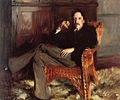Coats, jackets, and trousers
Three piece suits, "ditto suits", consisting of a sack coat with matching waistcoat (U.S. vest) and trousers (called in the UK a "lounge suit") continued as an informal alternative to the contrasting frock coat, waistcoat and trousers.
The cutaway morning coat was still worn for formal day occasions in Europe and major cities elsewhere, with a dress shirt and an ascot tie. The most formal evening dress remained a dark tail coat and trousers with a dark waistcoat. Evening wear was worn with a white bow tie and a shirt with a winged collar.
In mid-decade, a more relaxed formal coat appeared: the dinner jacket or tuxedo, which featured a shawl collar with silk or satin facings, and one or two buttons. Dinner jackets were appropriate when "dressing for dinner" at home or at a men's club.
The Norfolk jacket was popular for shooting and rugged outdoor pursuits. It was made of sturdy tweed or similar fabric and featured paired box pleats over the chest and back, with a fabric belt.
Full-length trousers were worn for most occasions; tweed or woollen breeches were worn for hunting and other outdoor pursuits.
Knee-length topcoats, often with contrasting velvet or fur collars, and calf-length overcoats were worn in winter.
By the 1880s the majority of the working class, even shepherds adopted jackets and waistcoats in fustian and corduroy with corduroy trousers, giving up their smock frocks.
Shirts and neckties
Shirt collars were turned over or pressed into "wings". Dress shirts had stiff fronts, sometimes decorated with shirt studs, and buttoned up the back.
The usual necktie was the four-in-hand and or the newly fashionable Ascot tie, made up as a neckband with wide wings attached and worn with a stickpin.
Narrow ribbon ties were tied in a bow, and white bowtie was correct with formal evening wear.
Accessories
As in the 1870s, top hats remained a requirement for upper class formal wear; bowlers and soft felt hats in a variety of shapes were worn for more casual occasions, and flat straw boaters were worn for yachting and other nautical pastimes.
Shoes of the 1880s had higher heels and a narrow toe.
Style gallery

1 – 1880
| 
2 – 1880
| 
3 – 1881
| 
4 – 1881
| 
5 – 1882
|
|---|---|---|---|---|

6 – 1882
| 
7 - 1883
| 
8 - 1887
| 
9-1887
| 
10-1885
|
2.Painter John Singer Sargent wears a formally pleated Ascot tie. His shirt collar has softly curled wings, c. 1880.
3.Hermann von Helmholtz wears a dark coat, waistcoat, and trousers with a stiff-fronted and stiff-collared shirt, German, 1881.
4.Theodor Mommsen wears a narrow necktie tied in a bow with his dark suit, German, 1881.
5.Vanity Fair sketch of agricultural scientist John Bennet Lawes portrays him in walking clothes. His coat with a waist seam and skirts cutaway in a smooth curve is worn with matching trousers and collared waistcoat, 1882.
60George Etiene Cartier wears a dark frock coat, a decorative double-breasted waistcoat, and a narrow bow tie. Montreal, after 1882.
7.Lawmen of Dodge City wear their coats with only the high top button fastened. Wyatt Earp (front row, second from left) wears a 3-piece "ditto" suit with contrasting binding around the coat collar and lapel, 1883.
8.Composer Anton Rubenstein conducts in formal evening wear (dark coat, trousers, and waistcoat, white shirt and tie), 1887.
9.Engineer Adolphe Alphand wears a topcoat or overcoat with a velvet collar, 1887.
10.Robert Louis Stevenson paces in his dining room, 1885. His wife Fanny, seated in an Indian dress, in the lower right corner

1-1886
| 
2-1887
| 
3-1882
| 
4-1885
| 
5-1888
|
|---|
2.Robert Louis Stevenson, 1887
3.Freeholders of Ruokolahti, Finland, 1882
4.Baseball pitcher Dan Casey, 1885
5.Cowboy, 1888, South Dakota
没有评论:
发表评论